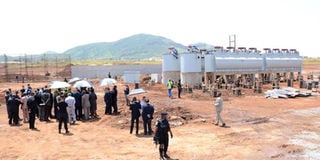Prime
Shs1 trillion spent on Osukuru mining project, says developer

Feasibility studies showed that both the phosphorite and iron ore buried within the Osukuru hills are of “high grade” but interlaced which requires “good technology” to separate them to be used for different purposes. PHOTO BY FREDERIC MUSISI
What you need to know:
- Mr L V Weidong, the company’s president, told Daily Monitor in an interview at the weekend they have so far spent nearly “half of the money” - Shs1.1 trillion ($310m) on foundational work including engineering, procurement and construction.
- The money is mobilised from Industrial and Commercial Bank of China, which is also involved in financing discussions for the East African Crude Oil Export pipeline.
- Guangzhou Dongsong Energy Group plans to manufacture fertilisers and have already undertaken several “studies on the suitability” of seven types of bio-organic fertilisers for among other crops such as maize, tea and tobacco around the country.
- According to the draft National Fertiliser Strategy, Uganda imports about 50,000 metric tonnes of fertilizers, which is still below the required one million tonnes annually.
Guangzhou Dongsong Energy Group, the Chinese company developing the carbonatite complex in Tororo District, is looking at between October and November to commission the fertilizer plant and a steel manufacturing plant by next year in July.
The $620m (Shs2.2trillion) project currently ranks as the largest mining venture in more than 30 years since the collapse of Kilembe mines.
Mr L V Weidong, the company’s president, told Daily Monitor in an interview at the weekend they have so far spent nearly “half of the money” - Shs1.1 trillion ($310m) on foundational work including engineering, procurement and construction.
“We have finished all necessary financial closures, but we have to move in steps,” Mr Weidong said.
The money is mobilised from Industrial and Commercial Bank of China, which is also involved in financing discussions for the East African Crude Oil Export pipeline.
Guangzhou Dongsong Energy Group plans to manufacture fertilisers and have already undertaken several “studies on the suitability” of seven types of bio-organic fertilisers for among other crops such as maize, tea and tobacco around the country.
According to the draft National Fertiliser Strategy, Uganda imports about 50,000 metric tonnes of fertilizers, which is still below the required one million tonnes annually.
The policy also indicates that the depletion of soil nutrients continues at an exponential rate, which shows that Uganda loses approximately 80 kilogrammes of nutrients per hectare per year through soil erosion and nutrient export through harvested crop biomas.
“Bio-organic fertilisers is what Uganda needs, in order not to repeat the mistakes done by China and most European countries of using chemicals which affected their soils,” Mr Weidong noted.
Guangzhou Dongsong, which was handed a 50-year mining licence in 2013, plans to tap into this gap and likewise tap into potential markets in neighbouring countries.
The 50-year mining license covers 265 square kilometers of the Osukuru hills in Tororo, which according to feasibility studies, contain 75million tons of phosphorite (the raw material for fertlisers), 213 million tons of iron ore, 429 tons of niobium, and 1 million tons of rare earth.
Guangzhou Dongsong which was also given 600 acres of land for the industrial complex situated within the Uganda-China Guangdong free zone of international cooperation was launched last Thursday by Finance minister Matia Kasaija.
Mr Weidong said feasibility studies showed that both the phosphorite and iron ore buried within the Osukuru hills are of “high grade” but interlaced which requires “good technology” to separate them to be used for different purposes.
“During the separation stage the residue (slag) produced shall be used to manufacture bricks and glass,” Weidong added.
Currently the company does not have plans to venture into processing of rare earth metals, which for now will be piled on the side, but Energy minister Irene Muloni, speaking last Thursday at the commissioning of the Uganda-China Guangdong free zone of international cooperation, hinted on giving the company a licence to process the rare-earth metals ‘if they continue to exhibit seriousness of this nature’.
Uganda is home to sizeable deposits of rare earth mineral like aluminous clays, yttrium, and rare metals such as gallium and scandium, whose exploration is yet to be prioritised. Rare earth metals such as alloys, are used in the construction and manufacturing of automobile (cars, aero planes) parts, and largely in electronics.
For the fertilisers’ production, Guangzhou Dongsong’s chief executive, Ms Jane Guo Yaqiong revealed they are currently undertaking evaluation, to be concluded by end of September, “together with other stakeholders” to have a clear picture of the local market.
Phosphate, the mineral used in manufacturing of fertilisers, was first mined in Uganda in in eastern Uganda until 1963. The Osukuru deposits were discovered later in the 1940s during the search for limestone for cement manufacturing.
The steel plant, expected to be ready by next year in July, will process the iron ore and is the core of Guangzhou Dongsong’s business with expected an output of 500,000 tons of steel per year after reaching maximum capacity - from hoes and iron bars.
Uganda’s iron and steel product imports averaged to around 440,000 tonnes, according to the National Planning Authority, at a bill of Shs1 trillion ($280m). On the other hand exports average to around 200,000 tonnes or Shs314b ($87m).
Guangzhou Dongsong currently employs 1,000 locals in Tororo, a number expected to rise when the industrial complex starts manufacturing at full capacity but Finance minister, Mr Kasaija further urged the company to “to ensure technology transfer” for more trickle-down benefits.




